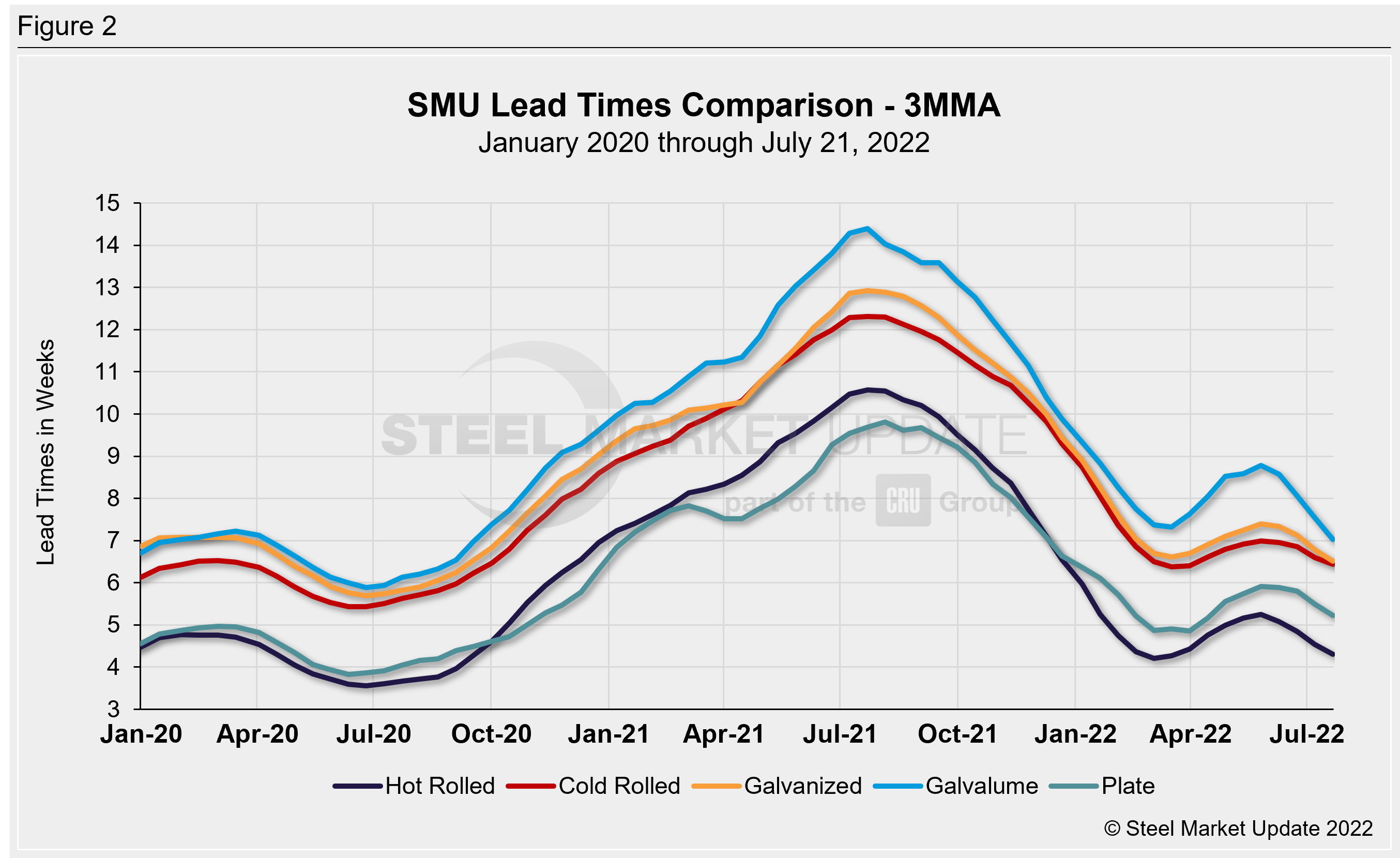Market Data

July 21, 2022
Steel Mill Lead Times: HR Dips Below 4 Weeks, Plate Less Than 5
Written by Brett Linton
Steel mill lead times through this week were relatively flat for sheet products and down slightly for plate, according to SMU’s latest market check. On average this week, lead times declined by 0.1 weeks across the board compared to early July and are down an average of 0.4 weeks compared to one month ago. Having gradually declined from the April peak, July lead times remain in line with early 2022 levels.
Buyers surveyed this week reported mill lead times ranging from 3–5 weeks for hot rolled, 4–8 weeks for cold rolled, galvanized and Galvalume, and 3–7 weeks for plate.
SMU’s hot rolled lead times now average 3.9 weeks, the first time they have been below 4 weeks since mid-February. HR lead times declined 0.1 weeks compared to two weeks ago and are down from a peak of 5.8 weeks in April. The lowest hot rolled level this year was 3.8 weeks seen in January and in February. The record low in our ~11-year data history was 2.8 weeks in October 2016.
Cold rolled lead times declined 0.1 weeks to 6.0 weeks, now the lowest level seen since early February. Galvanized lead times remained unchanged from earlier this month at 6.0 weeks. They were as low as 6.1 weeks back in March, and our record low was 4.8 weeks in February 2015. The average Galvalume lead time rose from 6.4 weeks to 6.5 weeks. One month ago Galvalume lead times were 6.7 weeks.
Mill lead times for plate are now at 4.8 weeks, down 0.3 weeks from our previous survey and down 0.5 weeks from one month ago. This is the first time plate lead times have been below 5 weeks since early March, and the lowest plate lead time this year was 4.1 weeks in early February. In our four-year history of plate lead times, the lowest we figure we have recorded was 3.2 weeks in May 2020.
Approximately 55% of the executives responding to this week’s questionnaire told SMU they were seeing stable lead times, up from 39% in our previous survey. 45% said lead times were slipping, in line with responses from the last month. Here is what a few of our respondents had to say:
“They are very short and mills can’t let them get any shorter.”
“Mills need orders.”
“For now they seem stable.”
“Order books are weak to nonexistent.”
“Mills will control lead time moving forward by removing capacity.”
“Below normal, but they cannot go down much more.”
“Lead times at mills are low and have very little room to move lower.”

Looking at lead times on a three-month moving average can smooth out the variability in the biweekly readings. As a 3MMA, all products were down between 0.2–0.5 weeks compared to two weeks prior and down as much as one full week compared to mid-June. The current 3MMA for hot rolled is down 0.2 weeks to 4.3 weeks, cold rolled eased 0.2 weeks to 6.4 weeks, galvanized is down 0.3 weeks to 6.5 weeks, Galvalume declined 0.5 weeks to 7.0 weeks, and plate slipped by 0.3 weeks to 5.2 weeks.

Note: These lead times are based on the average from manufacturers and steel service centers who participated in this week’s SMU market trends analysis. SMU measures lead times as the time it takes from when an order is placed with the mill to when the order is processed and ready for shipping, not including delivery time to the buyer. Our lead times do not predict what any individual may get from any specific mill supplier. Look to your mill rep for actual lead times. To see an interactive history of our Steel Mill Lead Times data, visit our website here.
By Brett Linton, Brett@SteelMarketUpdate.com







